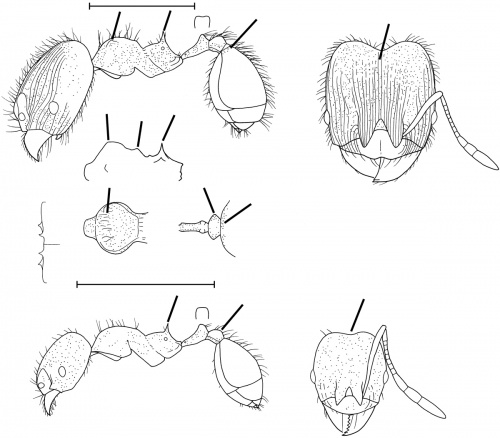Pheidole rectispina
| Pheidole rectispina | |
|---|---|

| |
| Scientific classification | |
| Kingdom: | Animalia |
| Phylum: | Arthropoda |
| Class: | Insecta |
| Order: | Hymenoptera |
| Family: | Formicidae |
| Subfamily: | Myrmicinae |
| Tribe: | Attini |
| Genus: | Pheidole |
| Species: | P. rectispina |
| Binomial name | |
| Pheidole rectispina Wilson, 2003 | |
Occurs on the floor of primary rainforest. (Wilson 2003)
Identification
See the description in the nomenclature section.
Keys including this Species
Distribution
From Wilson (2003): Atlantic slope of Costa Rica from lowlands to montane forest (Longino 1997) and Belize (Hummingbird Gap, near Stann, col. S. Peck).
Latitudinal Distribution Pattern
Latitudinal Range: 18.5859972° to 9.4817844°.
| North Temperate |
North Subtropical |
Tropical | South Subtropical |
South Temperate |
- Source: AntMaps
Distribution based on Regional Taxon Lists
Neotropical Region: Belize, Costa Rica (type locality), Guatemala, Honduras, Mexico.
Distribution based on AntMaps
Distribution based on AntWeb specimens
Check data from AntWeb
Countries Occupied
| Number of countries occupied by this species based on AntWiki Regional Taxon Lists. In general, fewer countries occupied indicates a narrower range, while more countries indicates a more widespread species. |

|
Estimated Abundance
| Relative abundance based on number of AntMaps records per species (this species within the purple bar). Fewer records (to the left) indicates a less abundant/encountered species while more records (to the right) indicates more abundant/encountered species. |

|
Biology
Castes
Worker
Minor
Images from AntWeb
  
| |
| Worker. Specimen code casent0635516. Photographer J. Longino, uploaded by University of Utah. | Owned by INBio. |
Nomenclature
The following information is derived from Barry Bolton's Online Catalogue of the Ants of the World.
- rectispina. Pheidole rectispina Wilson, 2003: 495, figs. (s.w.) COSTA RICA.
Unless otherwise noted the text for the remainder of this section is reported from the publication that includes the original description.
Description
DIAGNOSIS Similar in various traits to Pheidole bilimeki, Pheidole floridana, Pheidole hazenae, Pheidole rectiluma, Pheidole rectisentis, Pheidole rectitrudis, Pheidole sospes and Pheidole stomachosa, differing as follows.
Major: propodeal spine half as long as propodeal basal face and perpendicular to it; humeri low and subangulate; mesonotal convexity present; postpetiole from above elliptical, with angulate lateral margins; all of dorsal surface of head except occipital lobes, frontal triangle, and midclypeus carinulate; all of mesosoma and most of head and waist foveolate and opaque; anterior fringe of first gastral tergite shagreened.
Minor: propodeal spine half as long as the propodeal face and vertical on it; postpetiolar node somewhat depressed; occiput broad, its margin concave; all of head and mesosoma foveolate and opaque, no rugoreticulum and almost no carinulae.
MEASUREMENTS (mm) Holotype major: HW 1.00, HL 1.14, SL 0.56, EL 0.14, PW 0.50. Paratype minor: HW 0.44, HL 0.50, SL 0.46, EL 0.08, PW 0.30.
COLOR Major: dark, even blackish brown.
Minor: body medium brown, appendages yellowish brown.
Figure. Upper: holotype, major. Lower: paratype, minor. Scale bars = 1 mm.
Type Material
COSTA RICA: La Selva Biological Station, near Puerto Viejo, Heredia, col. E. O. Wilson. Museum of Comparative Zoology
Etymology
L rectispina, upright spine.
References
- Wilson, E. O. 2003. Pheidole in the New World: A dominant, hyperdiverse ant genus. Harvard University Press, Cambridge, MA.p (page 495, fig. major, minor described)
References based on Global Ant Biodiversity Informatics
- Dattilo W. et al. 2019. MEXICO ANTS: incidence and abundance along the Nearctic-Neotropical interface. Ecology https://doi.org/10.1002/ecy.2944
- Fernández, F. and S. Sendoya. 2004. Lista de las hormigas neotropicales. Biota Colombiana Volume 5, Number 1.
- Longino J. T. L., and M. G. Branstetter. 2018. The truncated bell: an enigmatic but pervasive elevational diversity pattern in Middle American ants. Ecography 41: 1-12.
- Longino J. T., J. Coddington, and R. K. Colwell. 2002. The ant fauna of a tropical rain forest: estimating species richness three different ways. Ecology 83: 689-702.
- Longino J. T., and R. K. Colwell. 2011. Density compensation, species composition, and richness of ants on a neotropical elevational gradient. Ecosphere 2(3): 16pp.
- Longino J. et al. ADMAC project. Accessed on March 24th 2017 at https://sites.google.com/site/admacsite/

